The Best Deal in Town: Renewable Energy for Interior Alaska
FCAC Renewable Energy Working Group members hung a banner reading “SALE! Wind Energy: Best Deal in Town” above the Johansen on Black Friday, drawing attention to the current research on energy costs, and encouraging shoppers to contact GVEA to urge them to bring more wind onboard.
The best deal in (and out of) town is in the air! Literally. Investing in renewable energy—specifically, wind power—isn’t just about saving money on electricity bills; it’s about creating a more resilient, sustainable, and cost-effective long-term energy system for our communities. We want (and need) an economy that’s affordable and not susceptible to volatile global pricing (remember what happened when Ukraine was invaded?).
The Big Picture: Alaska’s Renewable Energy Potential
A recent study by the National Renewable Energy Laboratory (NREL) revealed that transitioning Alaska’s Railbelt to 80% renewable energy is not only feasible but cost-effective. In the lowest-cost scenario, the net savings exceeds $100 million per year by the early 2030’s. This scenario would lead to about 76% renewable generation by 2040, with wind alone contributing up to 50% of annual energy generation.
For Interior Alaska, where energy costs are among the highest in the nation, this transition isn’t only an environmental imperative—it’s an economic opportunity.
Why Wind Power?
Wind energy is particularly well-suited for Interior Alaska. Here’s why:
Abundant Resources: The region boasts consistent and strong wind, especially in areas like Delta Junction and Fairbanks’ outskirts.
Seasonal Strengths: Wind power is strongest in the winter months, aligning with peak heating and electricity demands.
Economic Benefits: Wind projects can reduce reliance on expensive imported fuels, keeping energy dollars in-state.
Expediency: Wind power is the only type that can be built fast enough to address the energy shortfall we’re facing with the natural gas shortage from Cook Inlet.
Existing Success: GVEA’s Wind Projects
Golden Valley Electric Association (GVEA) has already tapped into wind energy with projects like the Eva Creek Wind Farm near Healy. Operational since 2012, Eva Creek produces enough electricity to power approximately 4,000 homes annually, offsetting nearly 25,000 tons of carbon emissions each year and making the air we breathe (and the air our friends and our children breathe) cleaner.
These projects demonstrate the feasibility of wind power in Alaska, but they didn’t happen by chance. Community advocacy, state funding, and forward-thinking utilities made them possible.
Impact on Rates
One of the most pressing questions for Alaskans is: How does wind energy affect my electricity bill?
While initial project costs can be high (similar to fossil-fuel projects), wind energy’s zero fuel cost means long-term savings. GVEA’s wind projects have helped stabilize rates by reducing dependency on volatile fossil fuel markets.
The Next Chapter: Proposed Projects
Several new wind projects are poised to expand Alaska’s renewable energy portfolio:
Delta Wind Farm: Located near Delta Junction, this proposed project could power thousands of additional homes with 36 Megawatts. An integration study is wrapping up, after which GVEA will decide if it’s feasible, followed by negotiation of the power purchase agreement.
Shovel Creek Wind Project: Situated northwest of Fairbanks, this initiative aims to diversify GVEA’s renewable energy sources further. It can be operational by 2027 and would provide 100-210 Megawatts of power, enough for more than 10,000 homes.
Both of these projects predict electricity costs ~30% less than what we currently pay. If realized, these projects could significantly boost Alaska’s renewable energy capacity, while creating jobs, cutting emissions, and saving us money along the way.
Challenges and Opportunities
No transition is without hurdles. Wind energy faces challenges like intermittency and grid integration, particularly in a state with vast distances and isolated communities. However, advances in battery storage and microgrid technology have made these obstacles surmountable. Similar to coal generation technology which has suffered from false starts and supply-line issues, wind energy will grow and mature as independent power producers mature and compete with one another. As wind energy is already as cheap or cheaper than fossil-fuel based electricity, this maturation means that wind energy will only get cheaper over time. This is because wind energy is powered by a freely-available, local, and virtually unlimited natural resource. Users do not have to pay for fuel, making the only investment an initial fixed cost and maintenance that is often less costly and resource intensive than fuel-based energy sources. Just like a home, once it is built, it is here to stay.
What’s at Stake?
Transitioning to wind energy isn’t only about reducing emissions; it’s also about securing a future where Alaskans are less vulnerable to global fuel price spikes and international markets. When Russia invaded Ukraine, fossil fuel supplies became uncertain; electricity and fuel prices skyrocketed for all of us. Earlier this year, the GVEA board stated that they had to enact a price hike of nearly 30% because our energy production is over-dependent on fossil fuels. According to NREL’s findings, achieving 80% renewable energy on the Railbelt (the network of of interconnected energy utilities along the road system) could save millions annually in energy costs while slashing greenhouse gas emissions.
Your Role in the Renewable Revolution
Let’s go after the best deal in Alaskan Power Generation. Here’s how you can help:
Support Local Projects: Advocate for wind projects like Delta Wind and Shovel Creek by contacting GVEA or your local representatives. Here’s how: 1) comment at GVEA board meetings; 2) contact your GVEA board member; 3) contact your local representatives. Communication can range from a sentence, letter, full-blown conversation, or anything in between. It does not have to be perfect. Feel free to use this information as talking points.
Get Involved: Find out more about proposed wind projects. Ask questions, challenge answers. Get involved in renewable energy advocacy groups by Googling “renewable energy advocacy [your region e.g. Fairbanks]” and contact those organizations. One great one we recommend is FCAC’s Renewable Energy Working Group!
Together, we can ensure that the best deal in town this holiday season is a brighter, greener future for Interior Alaska.

